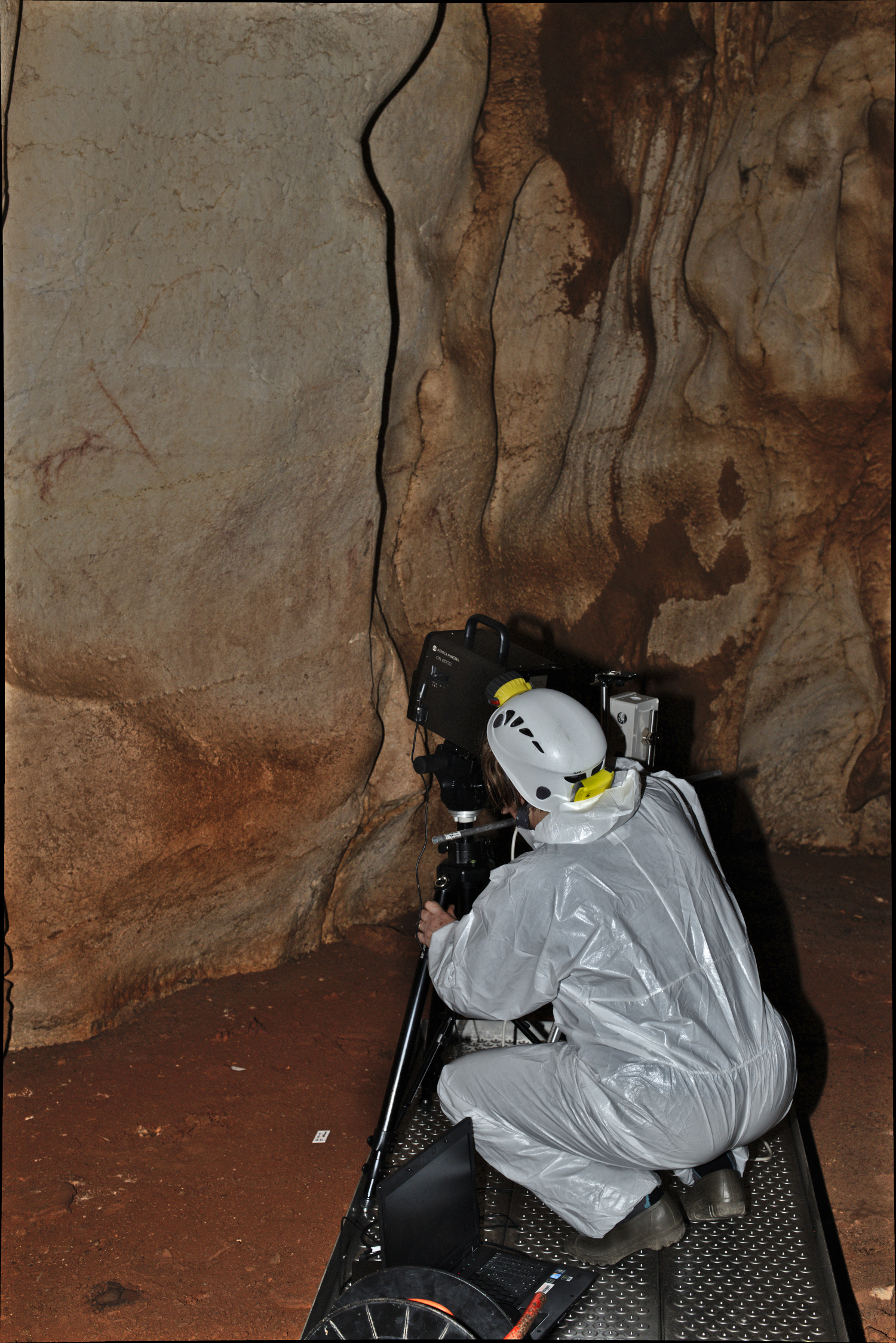The hidden secrets of the colors of cave paintings at prehistoric sites
The colors of cave paintings are of great interest because they provide information about the techniques and materials used. Studying them also allows fewer sample to be taken from ancient paleolithic works. Research in colorimetry by Dominique Lafon-Pham at IMT Mines Alès provides a better definition of the colors used in paintings by our ancestors.
Mammoths, steppe lions and woolly rhinoceroses have been extinct for thousands of years, but they have by no means disappeared from paleolithic caves. Paintings of these animals still remain on the walls of the caves that our ancestors once lived in or travelled to. For archeologists, cave art specialists and paleo-anthropologists, these paintings are a valuable source of information. Cave art, found at various sites in different regions and dating from a long period that covers several tens of thousands of years, reflects the distribution and evolution of prehistoric wildlife. Analysis of the complex scenes sometimes depicted — such as hunting — and study of the artistic techniques used also bear valuable witness to paleolithic social practices. They are an expression of the symbolic world of our ancestors.
Scientists examine and handle these works with minute care. “Permission to take samples of the painted works is only granted after a strict application process and remains exceptional. Decorated caves can contain a wealth of information but are also be extremely restrictive due to the fragility of the information itself,” explains Dominique Lafon-Pham. The researcher at IMT Mines Alès is developing measurement methods that do not require contact with the color and which help characterize rock paintings. She has been carrying out her work for several years in close collaboration with the French National Center for Prehistory (CNP). She alternates field work and lab experiments in partnership with Stéphane Konik, geoarcheologist at the CNP attached to the PACEA[1] laboratory.
“Colorimetric analysis isn’t a replacement for chemical and mineralogical methods of analysis”, Dominique Lafon-Pham stresses. In certain cases it does, however, provide initial information on the nature of the colorant material. The color alone is not enough to accurately trace the constituents of the mixes, but it does provide a clue. Comparing the colors in different works is a way to avoid taking samples of the pictorial layer from the walls of prehistoric caves. The researcher’s work helps contribute to a “detective investigation” led by archaeologists at scenes dating from several tens of thousands of years ago, where even the smallest piece of evidence merits examination.
The color and, more generally, the appearance of the drawings observed by teams of scientists in caves such as Chauvet and Cussac tell us some of the history of the chosen colorant material that was prepared and applied and has been exposed to the passing of time. It is a way of entering into the work through analysis of the ancient material used. Data produced from this analysis may allow parietal archaeologists to approach the work from the perspective of its creation and even its purpose, whereas conservation specialists are more interested in its evolution over time.
Our visual ability does not allow us to compare subtle differences in color that do not fall within our visual range. We do not have perfect color memory. In addition, the impressions created by an area of color are influenced by the surrounding chromatic environment. “When we can measure the color of a mark without the problem of deterioration due to aging, we will be able to establish similarities between works of the same color, whether they are on the same rock wall or not,” indicates the researcher at IMT Mines Alès.
Objectifying the perception of colors
This comparative method may seem a simple one, but it is important not to underestimate the complexity of the site. Lighting — very often artificial — alters the perception of the human eye. A colored surface will not appear the same when lit in two different ways. The aging of the rock also has an impact. The calcite that forms in the caves sometimes covers the paintings and alters the optical performance of the material, dulling and modifying the color of the depictions. In addition, moisture conditions vary with the seasons and between different sectors at a single site, leading to reversible variation in the colors perceived and measured. All these different impacts require set procedures to be put in place to identify, in the most objective way possible, the color produced by the interaction between light and material.

Measuring the color of cave paintings is not an easy task. Researchers use spectroradiometry and a whole set of associated procedures to keep the lighting constant for each measurement, as seen here in the cave of Chauvet.
Researchers use a spectroradiometer, an instrument that measures the spectral power distribution of a luminous radiance in the range of visible light, which is a physical scale that has no correlation with the color perceived by the eye. “The advantage of working at an underground site is that we can control the lighting of rock paintings,” explains Dominique Lafon-Pham. “We always try and light the work in the same way.” The situation becomes more complex when the scientists need to work outside. “We are currently taking measurements at the site of the Cro-magnon rock shelter,” explains the researcher. This site, listed as UNESCO World Heritage, is located in Dordogne in France and was a shelter for Cro-magnon men approximately 30,000 years ago. “The analysis of potentially decorated rock walls which are exposed to the open air is much more complex due to changes in the natural light. It is a real challenge in this situation to try and distinguish between very similar colors using measurements.”
Towards virtual caves?
The use of mixed reality (part-way between augmented reality and virtual reality) at cultural sites is increasingly common. This technology opens up new possibilities for transmitting knowledge such as through the creation of remote guided tours in an entirely virtual environment. The quality of the cultural mediation depends on the realism and exactitude of the features and objects in the virtual world. Taking objectified measurements allows standardization of data collection on the optical characteristics of the parietal art at prehistoric sites. Data collected in this way can be processed using modelling and realistic simulation tools. It provides some of the information required for the construction of virtual facsimile.
The scientific community is also keeping a close eye on such devices which capitalize on new media technology. Highly accurate virtual replicas of prehistoric sites could offer considerable research opportunities by enabling researchers to access sites regardless of how easily accessible they are or not. For conservation and safety reasons — such as the presence of high levels of CO2 in the air at certain times of the year — it is only possible to access caves for very short periods of time and under strict control of movement. Although Dominique Lafon-Pham agrees that these are particularly promising prospects, she nevertheless tempers expectations: “For the moment, the image generators we have tested are a long way off being able to render the subtlety of light and color variations that we see in reality.”
It will be a little longer before it is possible to create identical virtual replicas of paleolithic caves and their art with sufficient realism to allow quality cultural and scientific mediation. Nevertheless, this doesn’t stop the researchers at Mines Alès continuing to study the colors of rock paintings and, in particular, the way they looked at the time of our ancestors. 30,000 years ago, our predecessors painted and viewed their art by firelight, which has been replaced in caves today by very different electric lighting. “The light cast by fire flickers: what does that mean for the way in which the painted or engraved work is seen and perceived?” wonders Dominique Lafon-Pham. Another question: if researchers today are able to detect multiple shades of red in a single drawing using these systems of measurement, were these different shades seen by our Homo sapiens ancestors? If so, were they accidental or deliberate and did they serve a purpose for the artist?
[1] “From Prehistory to Today: Culture, Environment and Anthropology” (PACEA) laboratory. A mixed research unit attached to the CNRS, the University of Bordeaux and the French Ministry of Culture and Communication.




Leave a Reply
Want to join the discussion?Feel free to contribute!